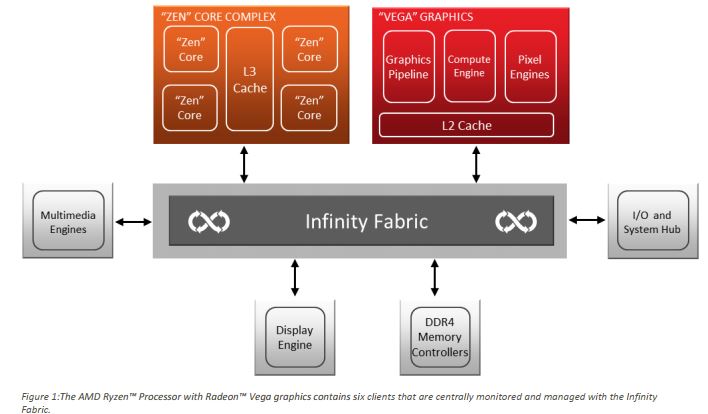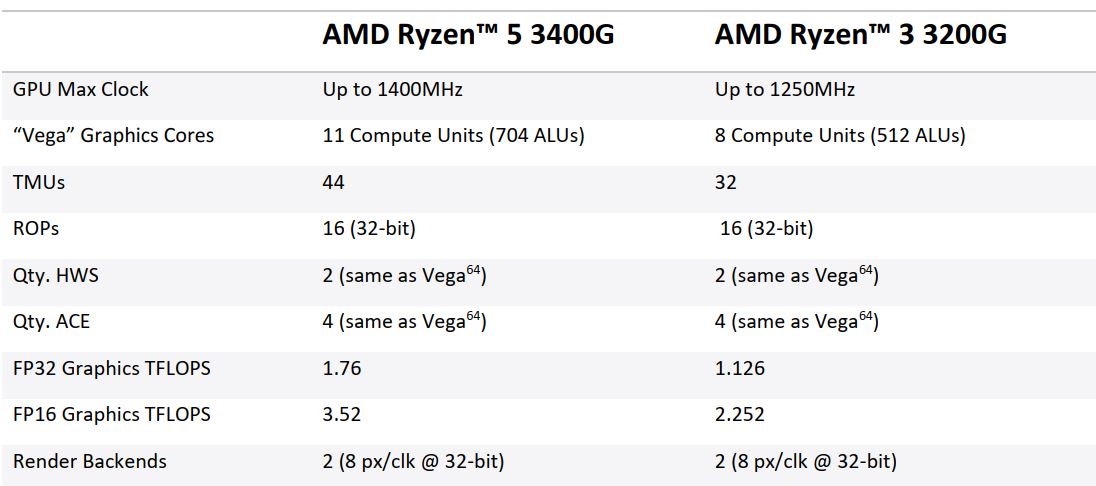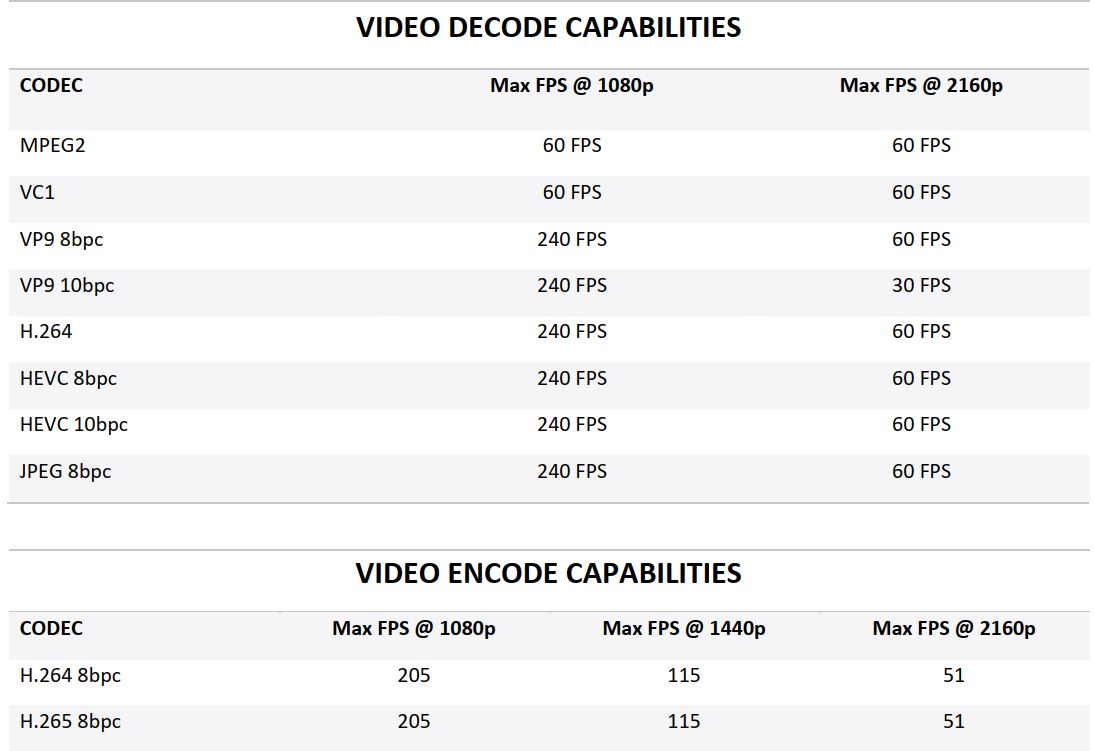Tom's Hardware Verdict
The Ryzen 5 3400G is a great niche part for low-cost systems built around integrated graphics, like budget gaming rigs, HTPCs, and basic computers. But keep your eye out for deals on cheaper previous-gen competitors.
Pros
- +
Radeon Vega graphics
- +
Price
- +
Higher frequencies
- +
Passable 1080p, solid 720p gaming
- +
Auto-overclocking PBO support
- +
Solder TIM
- +
Bundled cooler
Cons
- -
Lower performance in applications than alternatives
- -
Small performance advantage over previous-gen
Why you can trust Tom's Hardware
AMD's four-core eight-thread Ryzen 5 3400G comes packing AMD's Zen+ processing cores paired with AMD's RX Vega integrated graphics engine, a combo that's surely to land among the list of best CPUs for gaming because it can push playable framerates for low-resolution gaming if you're willing to make the trade-off of lower quality settings.
It's hard to believe the industry was stuck on four-core eight-thread processors as flagships for nearly a decade, but AMD has changed that paradigm entirely. Now instead of dropping ~$330 for a flagship quad-core eight-thread processor with insufficient integrated graphics like we did back in 2017, AMD's low-end Ryzen 5 3400G comes with four cores and eight threads for a mere $150; and you get a capable graphics engine that can even handle some FHD gaming, too.
However, AMD has a staggered naming convention and release cadence for APUs compared to its standard desktop processors, which can be confusing. Most new Ryzen 3000 series models come with the 7nm process and Zen 2 microarchitecture, but the Ryzen 5 3400G and Ryzen 3 3200G APUs still lag a generation behind, so the upgrade isn't as explosive as we've seen with AMD's other 3000-series models. Instead, the chips fall in line with our expectations for AMD's Ryzen 2000-series models.
AMD has made significant improvements, though. The move to from the 14nm process to 12nm, along with an optimized Zen+ design, yields solid performance improvements that include a nice bump to the CPU and GPU clocks. The more mature process paired with unlocked multipliers also facilitates higher overclocking ceilings for the CPU, GPU and memory. That combination, along with a beefier bundled cooler and Solder TIM, makes the Ryzen 5 3400G the processor to beat for systems built around integrated graphics for low-resolution budget gaming rigs.
Ryzen 3000-series "Picasso" APUs
The Ryzen 3000-series "Picasso" APUs snap into the tried-and-true AM4 socket, so they'll work with A320, B450, and X470/570 motherboards, along with the full gamut of AM4-compatible CPU coolers.
The 3000-series APUs come with the same basic design found in the first-gen models, but AMD moved forward to the Zen+ architecture, which features faster transistors in critical pathways that enable lower-latency cache and memory access. Those improvements facilitate a ~3% improvement to instruction per cycle (IPC) throughput, along with power efficiency gains borne of the transition from the 14nm process to the 12nm LP node that also equate to higher overclocking potential.
| Header Cell - Column 0 | Ryzen 5 3400G | Ryzen 5 2400G | Ryzen 3 3200G | Ryzen 3 2200G |
|---|---|---|---|---|
| Price (SEP) | $149 | $169 (Launch price) | $99 | $99 (Launch price) |
| CPU Cores/Threads | 4 / 8 | 4 / 8 | 4 / 4 | 4 / 4 |
| CPU Base/ Boost (GHz) | 3.7 / 4.2 | 3.6 / 3.9 | 3.6 / 4.0 | 3.5 / 3.7 |
| iGPU - CUs | RX Vega 11 | RX Vega 11 | RX Vega 8 | RX Vega 8 |
| iGPU Base/Boost (MHz) | up to 1400 | up to 1250 | up to 1250 | up to 1100 |
| Bundled Cooler | 95W Wraith Spire | 65W Wraith Stealth | 65W Wraith Stealth | 65W Wraith Stealth |
| Processor TIM | Indium Solder | Thermal Paste | Thermal Paste | Thermal Paste |
| L3 Cache | 4MB | 4MB | 4MB | 4MB |
| Memory Speed | up to DDR4-2933 | up to DDR4-2933 | up to DDR4-2933 | up to DDR4-2933 |
| PCIe Lanes | PCIe 3.0 x8 | PCIe 3.0 x8 | PCIe 3.0 x8 | PCIe 3.0 x8 |
| TDP | 65W | 65W | 65W | 65W |
| Process | 12nm | 14nm | 12nm | 14nm |
The more efficient process and architectural tweaks afford plenty of advantages, but increased power efficiency is among the most important. AMD increased the base and boost clocks on the Picasso APUs by 100 MHz and 300 MHz, respectively, over the previous-gen models, but due to the optimized design, the chips remain within the same 65W TDP envelope. The Radeon Vega graphics engines also move forward 150MHz.
Get Tom's Hardware's best news and in-depth reviews, straight to your inbox.
The Ryzen 5 3400G comes with four cores and eight threads for $149, while stepping back to the four-core Ryzen 3 3200G trades simultaneous multithreading (SMT) and lower CPU and GPU clocks for a $99 price point.
As before, both APUs come with unlocked multipliers for easy overclocking, but AMD also added Solder TIM and now supports the auto-overclocking Precision Boost Overdrive (PBO) feature with the Ryzen 5 3400G. The chip also features higher overclocking potential that AMD accommodates by stepping up from the bundled 65W Wraith Stealth cooler that came with the 2400G to the beefier 95W Wraith Spire cooler. Unfortunately, the Ryzen 3 3200G still comes with standard thermal paste and the same 65W Wraith Stealth cooler as its predecessor, but it's still sufficient given the 3200G's lower clock rates.

Memory support for both chips remains the same with (up to) dual-channel DDR4-2933. Aside from clock rates, the Ryzen 5 3400G's Radeon Vega 11 graphics engine and the Ryzen 3 3200G's Radeon Vega 8 graphics also remain unchanged. However, AMD's graphics drivers have improved quite a bit since our last encounter with the 2000-series APUs, adding new features like support for Microsoft's PlayReady 3.0 for ultra-HD 4K protected content acceleration and Radeon Anti-Lag, which reduces input lag in GPU-limited scenarios.



Overclocking
We experimented with both AMD's auto-overclocking PBO feature, which is a welcome addition to the Ryzen 5 3400G, and manual overclocking, but we found that manual tuning unlocked bigger performance gains. That holds particularly true for the graphics engine, which isn't impacted by the auto-overclocking feature.
We dialed in a 1.25V VCCDR SoC voltage paired with 1.38V vCore to bring the Ryzen 5 3400G's execution cores up to 4.2 GHz, which is a nice improvement over the maximum 4.0 GHz overclock we pulled off with the previous-gen 2400G. Pushing the graphics engine up to 1.2V also unlocked a solid 1700 MHz graphics clock rate, another nice improvement over the previous-gen's maximum 1555 MHz.
We also overclocked the memory to DDR4-3466 with 14-14-14-34 timings, which was a decent improvement over the 2400G's DDR4-2933. Given the big impact of memory throughput on integrated graphics performance, this yielded another nice bump to iGPU gaming performance, but it's noteworthy that most memory kits that support that high of a memory data transfer rate tend to be pricey for a budget build. Results will vary with cheaper kits.
We found the 3400G's stock cooler to be more than adequate for overclocking, topping out at 82C with our fully overclocked settings. During less-demanding workloads, the chip often hovered in the mid-70's.
Test Systems
| AMD Socket AM4 (X570) | |
| Ryzen 5 2400G/2400G, Ryzen 3 3200G, Ryzen 5 3600 | |
| MSI MEG X570 Godlike / ASUS B450M Plus (iGPU) | |
| 2x 8GB G.Skill Flare DDR4-3200 | |
| Ryzen 3000 - DDR4-3200, DDR4-3600 | |
| Second-gen Ryzen - DDR4-2933, DDR4-3466 | |
| Intel LGA 1151 (Z390) | |
| Intel Core i5-9600K, Core i5-9400F, i3-9350KF, i3-9100 | |
| MSI MEG Z390 Godlike / MSI MPG Z390 (iGPU) | |
| 2x 8GB G.Skill FlareX DDR4-3200 @ DDR4-2667 & DDR4-3600 | |
| All Systems | |
| Nvidia GeForce RTX 2080 Ti | |
| 2TB Intel DC4510 SSD | |
| EVGA Supernova 1600 T2, 1600W | |
| Windows 10 Pro (1903 - All Updates) | |
| Cooling | |
| Corsair H115i | |
| Custom Loop, EKWB Supremacy EVO waterblock, Dual-720mm radiators | |
| AMD Wraith Prism, Wraith Stealth Stock Coolers |
MORE: Best CPUs
MORE: CPU Benchmark Hierarchy
MORE: All CPUs Content

Paul Alcorn is the Editor-in-Chief for Tom's Hardware US. He also writes news and reviews on CPUs, storage, and enterprise hardware.